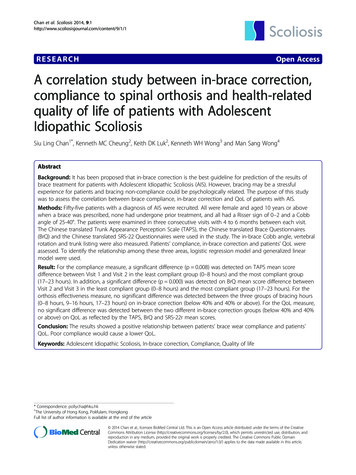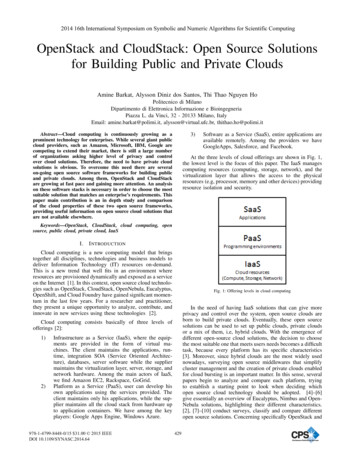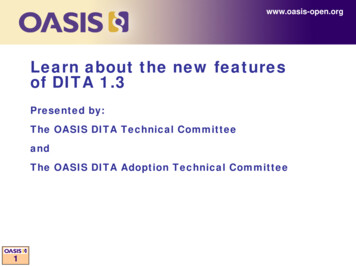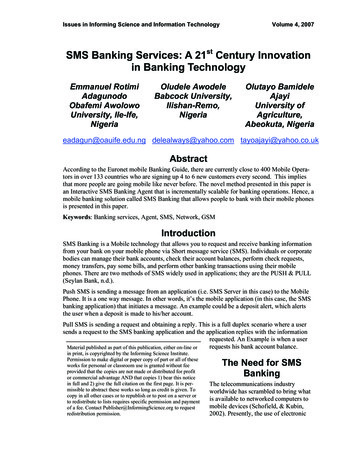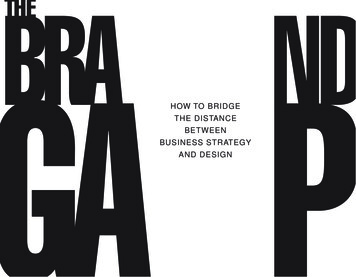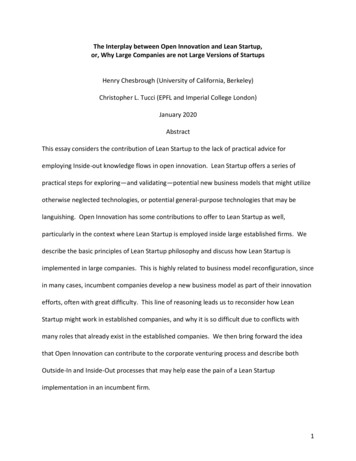
Transcription
The Interplay between Open Innovation and Lean Startup,or, Why Large Companies are not Large Versions of StartupsHenry Chesbrough (University of California, Berkeley)Christopher L. Tucci (EPFL and Imperial College London)January 2020AbstractThis essay considers the contribution of Lean Startup to the lack of practical advice foremploying Inside-out knowledge flows in open innovation. Lean Startup offers a series ofpractical steps for exploring—and validating—potential new business models that might utilizeotherwise neglected technologies, or potential general-purpose technologies that may belanguishing. Open Innovation has some contributions to offer to Lean Startup as well,particularly in the context where Lean Startup is employed inside large established firms. Wedescribe the basic principles of Lean Startup philosophy and discuss how Lean Startup isimplemented in large companies. This is highly related to business model reconfiguration, sincein many cases, incumbent companies develop a new business model as part of their innovationefforts, often with great difficulty. This line of reasoning leads us to reconsider how LeanStartup might work in established companies, and why it is so difficult due to conflicts withmany roles that already exist in the established companies. We then bring forward the ideathat Open Innovation can contribute to the corporate venturing process and describe bothOutside-In and Inside-Out processes that may help ease the pain of a Lean Startupimplementation in an incumbent firm.1
Open innovation has attracted a great deal of scholarly attention since Chesbrough’s(2003) initial articulation of the concept. The concept of “.purposive inflows and outflows ofknowledge across the boundary of a firm in order to leverage external sources of knowledgeand commercialization paths, respectively” (Chesbrough and Bogers, 2014) has primarily beenanalyzed in terms of the Inbound, or Outside-in path of knowledge flows. The Outbound, orInside-Out path of knowledge flows / commercialization paths is less studied, and appears to beless practiced as well. And there is a dearth of practical advice for what to do in order toliberate unused or under-used internal technologies that lack a clear path to market inside thefocal firm.This is not only an important area of inquiry in innovation management andentrepreneurship, but in strategic management more broadly. Over the decades, research instrategic management has changed emphases many times as the field has developed andbecome more established (Afuah, 2009). In the early years through the 1960s, corporateplanning, forecasting, and budgeting was the dominant topic, followed by the emphasis oncorporate portfolios, diversification, and growth/share in the 1970s. In the late 1970s and1980s, work shifted toward industry attractiveness, positioning, and industrial-organizationeconomics-influenced views on competition and rivalry, including game-theory-inspired modelsof two different firms or n identical firms competing in a market.It wasn’t until the late 1980s that attention shifted toward internal sources ofcompetitive advantage, or how and why firms could maintain advantages over longer periods oftime despite imitation / entry or being in a less-than-ideal environment / industry, and this lednaturally to a better understanding of path dependencies, resources, capabilities, and “core2
competences.” In this period of time and afterwards, it became understood that technologyand innovation management would become one of the key factors for understanding whatmade firms different—and in many cases, kept them that way. And from the mid-1990s to thepresent day, a whole host of innovation, entrepreneurship, and technology management issueshave risen to the forefront of strategic management thinking, including knowledge resources,new business models (originally rooted in Internet and e-commerce), network effects,“disruption,” the long tail, crowdsourcing, and so on.Thus, open innovation has become increasingly part of the toolkit for top executives aswell as highly relevant for academics interested in the canonical problems of strategicmanagement. Understanding the circumstances under which open innovation is useful fallssquarely into what Leiblein et al. (2018) classify as a strategic decision: open innovation isconcerned with how to allocate resources, how to organize, and how to win in the marketplace,and therefore simultaneously touches on, respectively, theories of strategic investment,theories of the firm, and theories of competitive advantage.One area where all these issues become salient is in the discovery and subsequentcommercialization of General-Purpose Technologies (GPTs). GPTs offer a broad set ofcapabilities, and it is far from obvious what the best uses for them are in advance, or what thebest business models to commercialize those uses are. However, if commercializedsuccessfully, we claim that the process of discovering and exploiting them may be a source ofcompetitive advantage for a long period of time.3
This essay considers the contribution of Lean Startup to this lack of practical advice foremploying Inside-out knowledge flows in open innovation. As we will discuss, Lean Startupoffers a series of practical steps for exploring—and validating—potential new business modelsthat might utilize otherwise neglected technologies, or potential GPTs that are languishing.Open Innovation has some contributions to offer to Lean Startup as well, particularly in thecontext where Lean Startup is employed inside large established firms. After describing thebasic principles of Lean Startup philosophy, we then discuss how Lean Startup is implementedin large companies. This is highly related to business model reconfiguration, since in manycases, incumbent companies develop a new business model as part of their innovation efforts.However, as we discuss below, business model reconfiguration is far from a given in largeenterprises. This line of reasoning leads us to reconsider how Lean Startup might work inestablished companies, and why it is so difficult due to conflicts with many roles that alreadyexist in the established companies. We then bring forward the idea that Open Innovation cancontribute to the corporate venturing process and describe both Outside-In and Inside-Outprocesses that may help ease the pain of a Lean Startup implementation in an incumbent firm.An Introduction to Lean StartupLean Startup is a relatively new concept to the world of innovation, and even more newto the world of corporate innovation. It is based upon the pioneering work of Eric Ries, in reconceptualizing the reasons for innovation failure in startup firms. This was most clearlydocumented in Ries’ (2011) seminal book, The Lean Startup. Ries applies the lean thinkingphilosophy found in the Toyota Production System to startup companies. Steve Blank (2013)has also played a critical role in this movement, as we will discuss below.4
The core insight of Lean Startup is that most startup firms fail for reasons that are notthe result of poor product development. Most of the time, the company is able to resolve thetechnical and operational challenges of developing its new product (or service) offering.Rather, the most common reason for failure in these startups is the lack of customeracceptance for this new offering. Yet most startups have no process to develop the market fortheir products—and test and validate the achievement of key milestones—in the same waythat they test and validate the development of the product itself.The traditional advice given to startups was to write a Business Plan that covered eachof the areas of the business. Once that plan was complete, the startup was then counseled tofollow the plan, update it as new information arrived, and launch the product that wasspecified and subsequently developed in the Business Plan. In essence, startups were advisedto behave like small versions of big companies.This is the polar opposite of Lean philosophy, according to Ries. Lean Thinking, inspiredby the Toyota Production System, is about reducing waste in industrial processes. Inproduction and manufacturing, “waste” is relatively easy to define as scrap materials,inefficiencies in the manufacturing process itself, and rework due to not addressing problems asthey arrive (Morgan and Liker 2006). Eventually, this line of thinking was applied not only tomanufacturing but also product and process development in large companies and evencorporate management, oriented toward minimizing “waste” in terms of inefficiencies in theproduct development process, time wasted in ineffective meetings, revisiting decisions,inability to be flexible if the situation changes frequently, and so forth (Flores et al. 2017a).5
More recently, Lean thinking has been applied further from the corporate innovationand operations areas toward creating and scaling startups. In this view, the most wasteful useof resources for a startup is to build a product that no one wants to buy. The Lean approachcarefully determines the minimum set of features in a product that will compel a customer tobuy the product, and then focuses the product development process on creating that set offeatures—no more, no less. This gives rise to a key concept in Lean Startup, the concept of aminimal viable product (MVP), which is highly related to the idea of a “minimum winning game”as articulated by Burgelman and Siegel (2007).The roots of MVP go back to Agile Software Development, where the creation ofcomplex code has gradually shifted away from a “waterfall” model of development (Boehm,1988; Brooks, 1987). In the waterfall development model, one sets a product requirementspecification, freezes it, then starts the software coding. Once the code meets the spec, theprocess tests the software for quality and for customer acceptance, and only then considersrevisions to the code for the next cycle of development. Note that there is a hiddenassumption in the waterfall model: the customer knows what the customer wants (hence thespecification), and we simply need to develop it for him or her. Note as well that there is nolearning during the code development. The only feedback comes at the end of each cycle.In recent years, this waterfall model has given way to an “agile” model of development.In the agile model, an initial spec is developed and code is written in “sprints” to meet the spec(often in 1-2-week cycles) and then immediately shared with users and customers for feedback.This feedback is used to refine the initial specification, and another sprint occurs. This createsan iterative loop of feedback that allows the developers to learn much more rapidly about what6
the users and customers really want from the software. Customers often react in surprisingways when they see the results of actual code, and either realize new needs/benefits, and/orredefine earlier needs/benefits. It can be shown that whenever customers are not entirelyclear in advance on their needs for a complex piece of software, agile approaches will convergemore quickly than waterfall approaches on a product that the customer will accept. This is theconnection to Lean: Agile methods use fewer resources and converge on an acceptablesolution much more quickly than the earlier waterfall method. So there is much less waste.Customer DevelopmentSteve Blank (2013) has added a key concept to Lean Startup, the concept of CustomerDevelopment.1 Just as the product must be developed, so too must a startup company identifyand seek out customers willing and able to buy its offerings. While Ries’ book advises startupsto perform market validation very early in the process, it was Blank who figured out asystematic process to do that. Blank develops a four-stage process to achieve this:a. Customer discoveryb. Customer validationc. Customer creationd. Company buildingIn the discovery phase, it is critical in Blanks’ conception to get out of the building toidentify customers. Using the MVP as an artifact, a startup would attempt to get a prospectivecustomer to commit to buy the product. Critically, one only exits this stage when there is anactual order from an actual customer. Note that this selling activity comes much more quicklythan would be the case in a traditional waterfall innovation model. It also requires a selling7
capability to be available in the earliest phase of the innovation process inside the startup. Itdovetails nicely with agile methods, because the customer often requires changes to the MVPbefore committing to buy it (and those changes only surface after the innovator asks thecustomer to buy). It is imperative to make those required changes quickly, to get back to thecustomer and close the sale. If the customer is still unwilling to buy, the startup can eithermodify the product again, or try a different prospective customer the next time.The customer validation process starts once an initial order has been received. In thevalidation stage, the company seeks other customers also willing to buy. Once multiplecustomers and multiple orders have been received, the validation stage is completed. In thisstage, the company now has multiple customers, and is looking for a common pattern thatconnects the customers together. The company can now identify a market segment for itsproduct.In the customer creation stage, the company is building a sales process, to reliablyreplicate the validation, and to understand the cost and time required to make a new sale inthat market segment. If the cost to sell to the customer is too high or takes too long, then thestartup might try a different channel of distribution.In the company building stage, the company now has the information needed to sell itsoffering, scale its business and rapidly grow its customer base. By waiting until the validationand customer creation stages are complete, the startup is less likely to waste time and moneyon the wrong market segments or distribution channels. Scaling too early is another way togenerate waste in abundance, and is very “non-Lean.”8
Of course, the concept of Lean Startup is not without its critics. For example, Felin et al.(2019) question whether the concept or process is useful for truly radical or highly innovativeideas, decrying / questioning three main elements: (1) The poor analogy between leanmanufacturing and startups and whether the principles can be directly applied; (2) Whethercustomers or potential customers are the best sources of information for very radical ideas; and(3) How useful the Business Model Canvas is as a practical, initial tool, rather than an“aspirational ending point” due to the complexity of business models and the effort ofcompleteness required. Overall, they argue, Lean Startup guides startups into the kinds ofideas that can easily and quickly be tested by customers.That said (and perhaps due to the fact that many technology startups are in factamenable to customer empathy and testing), the Lean Startup approach has been verysuccessful and it was only a matter of time before large companies started experimenting withthe concepts to develop “intrapreneurship” in the hopes of successfully incubating andcommercializing new ideas. It is to this topic that we turn in our next section.Lean Startup in large corporations: Tensions and paradoxes"This is the true promise of the Startup Way: a management system thatcontains within it the seeds of its own evolution by providing an opportunity forevery employee to become an entrepreneur. In doing so, it creates opportunitiesfor leadership and keeps the people best suited for leadership in the company,reduces the waste of both time and energy, and creates a system for solvingchallenges with speed and flexibility, all of which lead to better financialoutcomes." (Ries, 2017, p. 316).The foundational work for Lean Startup originated in the context of startup companies.More recently, people have begun to apply these concepts inside large organizations. This is9
quite a different context than a startup context. The Lean Startup pioneers like Ries and Blankactually underplay this different context, in our opinion. Just as it was an error to tell startupsto behave like small versions of large companies (e.g., writing and executing Business Plans), sotoo is it an error to tell large companies to behave like large versions of startup companies.Steve Blank (2010) has an extremely useful insight about the differences betweenstartups and large established companies. A startup is searching for a scalable business model,in his view. A large, established company has already found that business model, and hasalready scaled it. So the large company is focused on executing the business model it haspreviously found. As we shall see, this difference between searching for a new business modeland executing an existing model has many implications for why large companies cannot—andshould not—simply mimic the behavior of startups.For academic scholars, Blank’s distinction evokes Jim March’s (1991) powerfulobservation about exploration processes, and how they differ from exploitation processes.Blank sees startups as driven entirely by the former (until they achieve product-market fit, andare ready to scale up). Established companies, by contrast, have achieved their scale andrelative longevity due to their mastery of exploitation processes. This basic insight was furtherdeveloped into an important stream in the strategic management literature, corporateambidexterity (for example, Volberda 1996; O’Reilly and Tushman 2013; Raisch et al. 2009).To relate corporate ambidexterity to entrepreneurship, a startup is really a singleproject organization, whereas a large company has many projects, and must allocate resourcesand attention across a portfolio of projects. There is no single best way to allocate resources10
across multiple innovation projects, but some heuristics have emerged over time. McKinseyhas promoted the idea of time horizons 1, 2, and 3 (Figure 1), and argued that companiesshould allocate their innovation budget across these three horizons (Baghai, Coley, and White,2000). Horizon 1 is the next product (in the current market), Horizon 2 is the next generationproduct (in the current market or perhaps in an adjacent market), and Horizon 3 is the longterm (new kinds of products and/or new kinds of markets). Google has publicly stated that itfollows a 70/20/10 allocation to Core, Adjacent, and Transformational projects that appears tocorrespond well to these three categories.[insert Figure 1 about here]A critical element of this resource allocation approach of 70/20/10 is that the companymust allocate its resources to each of the three in a top-down fashion and then have thediscipline to maintain that allocation over time. That is, the organization must not raid thefunds in Horizon 2 or 3 projects to make up for any shortfall needed to fund Horizon 1 projects.The reason that Horizon 1 projects tend to crowd out the other two categories comes from themany data advantages these projects have. Being closer to the Core business, the customersand markets are well known. The needs of these customers are likely well understood, andcompetitors are similarly better understood. The data on pricing, volume, and likely rate ofmarket uptake are based on operating history, not guesswork. All of these advantages makethe business case for Horizon 1 projects seem far more credible than the “guestimates” used tosupport the business case for Horizon 2 or 3 projects. This greater credibility causes manycompanies to over-allocate resources to the near term, incremental projects at the expense of11
longer-term, more potentially valuable initiatives. Note that the startup firm does not worryabout these issues.2A second key difference in lean processes between startups and large companies is thata large company has an existing business model, and often seeks opportunities that fit with thatmodel (Chesbrough and Rosenbloom 2002). The large company shuns opportunities that mightdisrupt its current business model, whereas a startup company has no existing business orbusiness model to protect. The large company rightly must protect its current business, even asit seeks new business opportunities. This hearkens back to Abernathy and Clark’s (1985) earlyresearch in technological “disruption,” where incumbent firms were thought to be in danger ofclinging to their existing business model in the face of innovations that had the potential todisrupt market and technological linkages. We discuss this specific issue next.Challenge 1: Business model reconfigurationIn thinking about business model innovation, we find it helpful to draw a distinctionbetween business model design and business model reconfiguration (Massa & Tucci 2014).Business model design is the very first business model developed by a company (Zott & Amit,2010). Usually it is associated with entrepreneurial activity as a startup decides on its firstbusiness model, but it may also refer to the initial commercialization path for a GPT from amore established company as well. The startup may “pivot” in the initial stages and changesome aspects of its business model as part of the business model design process. However,once the company scales up its business model, further changes require business modelreconfiguration, which refers to the replacement or addition of a new business model inside anestablished company (Massa & Tucci 2014).12
To synthesize the two concepts developed above, Figure 2 below shows a possiblerelation between business model innovation and exploration / exploitation needs oforganizations. This distinction will be useful later on when we discuss validating corporatebusiness models. In the early phase of the organization, the startup engages in exploration asthey search for their first business model.[Insert Figure 2 about here]Business model reconfiguration, as opposed to business model design, rarely sees greatsuccess (Johnson et al. 2008; Markides & Charitou 2004; Markides & Oyon 2010). This could bedue to a number of reasons, sometimes rooted in the “conflict” between the new businessmodel and the old one (Markides & Charitou 2004), or what Chesbrough (2010) calls“structural” impediments to business model innovation. In this sense, the conflict could betruly “strategic” (in the Machiavellian sense) in that the managers responsible for the oldbusiness model sense a threat as the new one is likely to compete with (and win against) theold one. Thus, one of the reasons that business model reconfiguration is so difficult is that arational manager, fully aware of the new business model and its implications, actively seeks toundermine or even scuttle the new business model to maximize his or her own careeraspirations (number of employees, business unit size, bonus based on unit’s performancerather than corporate performance, and so forth).However, there could be less nefarious reasons why business model reconfiguration isslow to be adopted. Many of them have to do with path dependencies, or current situationsthat constrain future activity due to the inability to change behavior or course instantaneouslyas new information arrives (Coff & Laverty 2010). Some aspects could be at the “cognitive”13
level of managers (Chesbrough & Rosenbloom 2002; Chesbrough 2010), who unwittingly areagainst adopting certain changes due to the “heuristic logic” that they use to help filterinformation as being valuable. Thus, changes that go against the “dominant logic” (Prahaladand Bettis, 1986) of the current business model—the current view from top management ofhow the company competes and how the environment operates—might be perceived as lowerquality opportunities. If they instead are interesting opportunities but being incorrectlyignored, the firm may fall into a “dominant logic trap” (Chesbrough 2003).In addition to ignoring signals of quality due to already established routines, there canbe other types of routines that contribute to rigidity in business model adoption. In the face ofthe need to change, other kinds of organizational inertia or impediments to changing at anorganizational level could come into play. These could be due to management processes(routines established around all business processes), modes of organizational learning (currentsources of information and how those are understood and adopted within the organization),and established / legitimate ways of change within the organization in general.Abernathy and Clark (1985) complements the above with an interesting point of view ofwhat they call “market / customer linkage disruption” which we now often think of precisely asbusiness model innovation as opposed to technological innovation / disruption. Marketdisruption could be new customer bases, new customer applications, new distributionchannels, new knowledge of customer demand, and new modes of communication required.Part of the issue with “market disruption” is that it most likely requires some kind of businessmodel thinking; yet, if the organization continues on with business as usual in these market-14
facing aspects or similar ones, they are likely to miss the opportunity to move into whatAbernathy and Clark call a new “niche.”A third category could be related to the understanding of the business model itself.Describing, communicating and agreement about business models is difficult in a large,established company. In a large enterprise, there may not be complete agreement about whatthe company’s current business model actually is. Therefore, there is a cognitive narrative /mutual understanding story that relies on the business model as a communications tool (Massaet al., 2017). Without some kind of consensus throughout the organization, differentstakeholders end up using different “languages” in decision-making processes, which leads to atthe least longer decision processes and at the worst, paralysis and missed opportunities.Computational complexity of business models also complicates business modelreconfiguration (Massa et al., 2018). The number of combinations and permutations ofbusiness model elements is very large, if not infinite. Much prior research on business modelsbreaks down business models into “components” that represent different functions of abusiness and different levers for profitability (e.g., Afuah and Tucci, 2000; Osterwalder andPigneur, 2009). Usually there are anywhere from four to ten components of a business model,although in all Massa et al. (2017) identified 180 unique components proposed in the businessmodel literature over the last twenty years! Not only is this a large number of items to digest,each of the components might have many variations, and the combination of components ismultiplicative, thus leading to considerable complexity in understanding and agreement amongdecision makers and indeed amongst employees. This complexity amplifies the cognitivelimitations of business models noted earlier.15
Furthermore, beyond the sheer number of combinations of business model elements,the elements themselves might be interdependent and therefore cannot be changed one at atime without having unintended consequences. This is a different kind of complexity (cf. Massaet al. 2018) but is no less important. It is difficult to hold all elements but one constant in aceteris paribus sort of analysis, and then manipulate one without having it affect one or moreother components. Thus, it is difficult to predict the overall effect of small changes in abusiness model, let alone large changes, making systematic analysis difficult and impedingadoption.Finally, managers we have interviewed sometimes pose the problem this way: “I takethe risks to explore a possible new business model, and perhaps to obtain an initial validation.But my successor is the one who receives the credit, should the new model prove valuable.” Sothere can also be a temporal mismatch between risk and reward in business modelreconfiguration inside large companies.As we will discuss below, the resources being reconfigured are already working at scalein an established company. This can make them rigid and inflexible when it comes toexperimenting with different combinations of elements, thus making Lean Startup as it iscurrently conceived impractical in a large corporation.Challenge 2: Tight integration with the corporate contextThe ambidexterity and business model concepts developed above have manyimplications for Lean Startup, and all of them imply that it will be much, much harder to employLean Startup inside a large company than inside a startup. Here, we focus on three, thoughthere are many more in practice (and these follow the pattern described here).16
First, consider the concept of MVP. This is a vital concept in Lean Startup, and helps toperform Customer Discovery in Steve Blank’s process. Yet to a Manufacturing and Qualityorganization, MVP sounds like a “quick and dirty” approach. These groups have worked hard(using Six Sigma, Total Quality Management, and other techniques) to train such “crap” out ofthe process in a large company. They will seek to eliminate this quick and dirty prototyping.Equally, they will make sure that they do not have to support something in the field that hasbeen developed outside the normal, quality-controlled processes of the company. But thisfundamental tension is nowhere acknowledged in the many writings of Lean Startup advocates.Second, consider the concept of Customer Discovery. This requires the developer totalk directly to customers who can make a purchase decision, in order to get direct feedback,identify needed changes, and rapidly learn and iterate to make that all-important initial sale.Every large organization we know has a Sales function that regards this as dangerous, both tothe company’s sales in the current quarter or y
An Introduction to Lean Startup Lean Startup is a relatively new concept to the world of innovation, and even more new to the world of corporate innovation. It is based upon the pioneering work of Eric Ries, in re-conceptualizing the reasons for innovation failure in startup firms. This was

